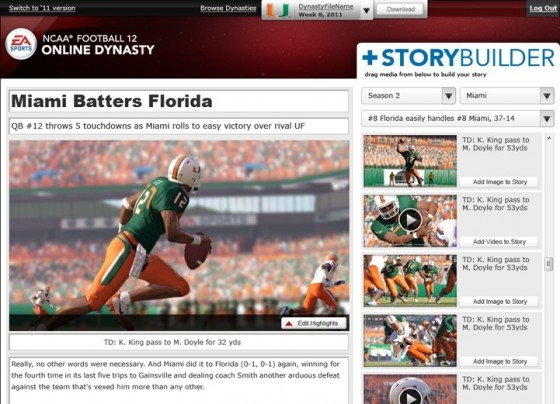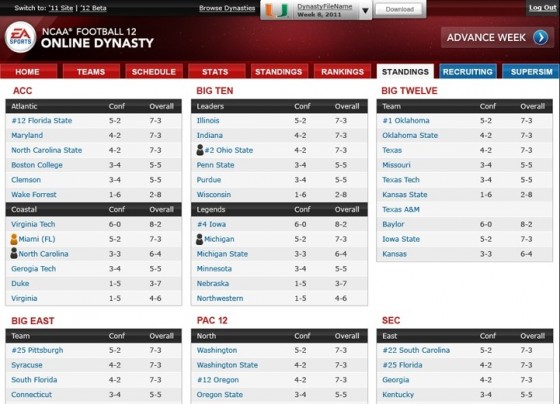

Everybody loves a powerhouse team in the NCAA Football series, but after a few consecutive national championships doesn't it get a little old?
The nation's top schools start each recruiting cycle with a bevy of talent that wants to enroll. Plus with nothing but high-quality pitches, it's not too much trouble for elite programs to consistently sign five-star prospects. Building a great roster out of nothing, though, can be a real challenge. The path from one-star to six-star program is long, and it's a true test for the NCAA Football dynasty player. I've compiled a set of tips for anyone just starting out in their attempt to build, or rebuild, a program.

1. Know how you play
Before you start planning how you’re going to overhaul a team in NCAA Football 12, take a step back and think about your own play style. Even if you use multiple teams and playbooks, you probably have some basic tendencies that you revert to when a game isn’t going the way you planned.
Think critically about these tendencies and how they affect how you use certain players. If you can acknowledge your weaknesses as a player, you’ll be able to figure out how to compensate, especially when you’re roster doesn’t have enough talent for you to get away with too many blunders.
2. Survey your depth chart
With a poor team, it’s especially important to know your depth chart by heart. You’re not Alabama, where the top three guys at every position are all going to be great. Most of your players are going to have legitimate weaknesses, and you need to be aware of them.
Also, don’t be afraid to play players out of position. If both of your safeties are slow, you’re going to give up a ton of long plays, no matter the overall rating. Instead, take your fastest DB and put him at a safety spot. Sometimes your safeties are going to play better at linebacker, especially against wide-open passing offenses. The overall rating is a starting point, but don’t let it be the ending point.
3. Choose talent over need
It goes without saying that if you want to build a program, it’s going to depend on your recruiting. When you’re starting out, your roster is going to have more holes than a cheese grater. But the problem you face lies in which holes should be plugged first?
In year one with a poor program, you just need to recruit the highest-rated players that you can convince to come to your school. Don’t worry about positional needs unless you literally have nobody else. Don’t worry about signing too many players at one position either. If you can get five three-star receivers in a class, take them! You’re in no position to turn down a talented player in favor of a less-talented player at a “need” position. Plus, there are all kinds of surprises in player ratings that are kept under the hood during the recruiting process. In my first year of one dynasty with a one-star program, I signed four three-star receivers who immediately became my two highest-rated receivers, my highest-rated halfback and my highest-rated quarterback.
4. Find specialists
By specialists, I don’t mean special teams players. I'm talking about guys who are particularly good at one thing. When you’re signing a four- or five-star player, their ratings are going to be generally good across the board. But that doesn’t mean your lower-rated players are going to be bad across the board. No, a two-star player at a skill position isn’t going to come in at 80 overall. But one-, two- and three-star recruits will often have very high ratings in particular categories that make them lethal players, far exceeding the performance you’d expect from their overall ratings. Your job is to find them.
5. Know your limits
Until you build your program up for a few years, recruiting is going to be an uphill battle. With a one- or two-star program, you really shouldn’t waste too much time gunning for four- and five-star prospects. The other schools that you’ll be competing with for those players will have better ratings on most, if not all, of their pitches. The notable exceptions are Junior College players, who generally get less interest, and athletes, for whom the CPU usually has an inexplicable blind spot.
Also, since your ratings on most pitches will probably be low, it’s going to be hard for you to come from far behind and land a recruit. If you’re can’t get into a recruit’s top 10 schools within the first couple weeks of the season, cut bait and move on to someone else. Focusing on your pipeline states is also particularly important for a low-prestige school. Those pipeline bonuses are key, and if the pipeline state is your college’s home state, having the A+ “Proximity to Home” pitch is crucial. It’s also a good idea to take players from Texas, California and Florida whenever possible. These states produce the most talent, so building pipelines will pay huge dividends in the future, even if you have to sign and keep some scrubs to acquire and maintain them.
Also, always, always compare pitches when you’re rated higher in a pitch than one of your competitors for a recruit. You’ll earn the same number of positive points as you would if you just made the pitch for your own school, your competitor will suffer (even if it’s just a little bit), and unlike NCAA’s recruiting system from a few years ago, you won’t anger a recruit into hanging up on you.
6. Win
As obvious as this seems, it’s hard to overemphasize the importance of winning to rebuilding a program. Winning increases your program prestige, which has huge effects in the NCAA series. For one, recruiting is the obvious key to building a stronger program, and every additional star opens up a new set of recruiting possibilities, as higher-caliber players will be interested in your school at the start of each recruiting cycle. Winning will also improve many of your recruiting pitches, which makes it easier to land the the top players you need to improve your overall talent. Finally, program prestige has historically had an impact on how much your players progress during each offseason. It’s why good teams stay good and bad teams stay bad. And it’s your ticket to the big time.

Final Thoughts:
There's no one-size-fits-all approach to rebuilding a dynasty. Every new dynasty has its own unique attributes and player sets, which gives the mode serious replay value. But these tips should apply across the board, and this overall approach has helped me through many years of rebuilding programs. Later this month, I'll take a look at what I see as the five most difficult teams to use in a new dynasty, as well as five teams that are set up well for a rebuilding effort.



